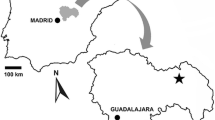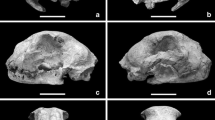Abstract
This paper describes new fossils of Equus huanghoensis from an Early Pleistocene bed in Nihewan, Hebei Province, which confirms the classification of E. huanghoensis by Chinese researchers. The new fossils include a relatively complete male skull and mandible with all upper and lower dentition, a broken female skull with fragment of mandible and a broken Mc III of Equus sp. The fossils were collected from the Yangshuizhan site of Nihewan. The age of the formation is about 1.6 Ma. The new materials verify some classification characteristics based on teeth published in previous descriptions. These characteristics include large teeth size, short protocone, and tilted protoloph and metaloph. We have added to these characteristics of large skull size, a developed protuberantia supramagna, pentagonal nuchal side, weak Pli cabaline, simple enamel plications; a series of new characteristics strikingly different from the other Equus horses. The broken Mc III is similar to Equus qingyangensis from Qingyang, Gansu
Similar content being viewed by others
References
Ao H, Mark J D, An Z S, Xiao G Q, Li Y X, Zhao H, Qiang X K, Chang H, Chang Q F, Wu D C. 2013. Magnetostratigraphic evidence of amid-Pliocene onset of the Nihewan Formation Implications for earlyfauna and hominid occupation in the Nihewan Basin, North China. Quat Sci Rev, 59 30–42
Azzaroli A. 1965. On the two Villafranchian horses of the Upper Valdarno. Palaeont Ital, 59 1–12
Azzaroli A. 1966. Pleistoeeoe and living horse of the old world. PalacontItal, 61 1–46
Azzaroli A. 1982. On Villafranchian palaeoarctic equids and their allies. Palaeont Ital, 72 74–97
Azzaroli A. 1992. Ascent and decline of monodactyl equids A case forprehistoric overkill. Annales Zool Fennici, 28151–163
Barbour G B. 1924. Preliminary observation in Kalgan area. Bull Geol Soc China, 3 167–168
Chow M Z, Chow B X. 1965. Note on Villafranchian mammals of Lingyi, Shansi. Vert Pal Asiat, 9 223–234
Chow M Z, Liu H Y. 1959. Fossil Equine teeth from Shansi. Vert Pal Asiat,1 133–136
Deng T, Xue X X. 1998. Phylogenetic relationships of the Chinese fossilspecies of the genus Equus (perissodactyla, equidae). Sci China SerD-Earth Sci, 42 449–455
Deng T, Xue X X. 1999a. Chinese Fossil Horses of Equus and Their Environment. Beijing China Ocean Press. 1–158
Deng T, Xue X X. 1999b. Equus qingyangensis sp.nov. (perissodactyla,equidae) from the Early Pleistocene of Qingyang, Gansu, China. Vert Pal Asiat, 37 62–74
Dong W, Fang Y S. 2005. Fossil Equids (mammals) from the Tuozidong, Nanjing (China) and its significance. Vert PalAsiat, 43 36–48
Eisenmann V, Alberdi M T, de Giuli C, Staesche U. 1988. Methodology. In Woodburne M et al., eds. Studying Fossil Horses. Leiden E J Brill. 1–71
Eisenmann V, Baylac M. 2000. Extant and fossil Equus (mammalia, perissodactyla) skulls A morphometric definition of the subgenus Equus. Zool Scr 29 89–100
Eisenmann V. 1980. Les chevaux (Equus sensu lato) fossiles et actuels Cranes et dents jugales superieurs. Paris Cahiers Paleontol. l–186
Eisenmann V. 1988. Tentative typology and biostratigraphy of some Middleand Late Pleistocene western european horses. J Quat Sci, 1 103–109
Eisenmann V. 1996. Quaternary horses Possible candi dates to domestication. In Proceedings of the XIII Congress. International Union of Prehistoricand Protohistoric Sciences, Forlì, Italia. 8–14
Forsten A. 1988. The small caballoid horse of the Upper Pleistocene and Holocene. J Anim Breed Genet, 105 161–176
Forsten A. 1986. Chinese fossil horses of the genus Equus. Acta Zool Fen, 181 1–40
Liu H Y. 1963. A new species of Equus from Locality 21 of Zhoukoudian, Vert Pal Asiat, 7 318–322
Liu H Y. 1973. Fossil horses in Peking Man site. Vert Pal Asiat, 11 86–97
Lui H Y, You Y Z. 1974. New Materials of Equus yunnanensis in Yuanmou,Yunnan. Vert PalAsiat, 12 126–136
Pei W Z. 1961. Fossil mammals of Early Pleistocene age from Yuanmo(Ma-Kai) of Yunnan, Vert PalAsiat, 1 16–30
Prado J L, Alberdi M T. 1996. A cladistic analysis of the horses of the tribe Equini. Palaeontol 39 663–680
Qiu Z X, Deng T, Wang B Y. 2004. Early Pleistocene Mammalian Faunafrom Longdan, Dongxiang, Gansu, China. Palaeont Sin New Ser C, 27 1–198
Qiu Z X, Huang W L, Guo Z H. 1987. The Chinese hipparionine fossils. Palaeont Sin New Ser C, 25 1–250
Sisson S. 1956. The anatomy of the domestic animals. Philadelphia & London W. B. Saunders Company
Tang Y J, Zong G F, Xu Q Q. 1983. Mammalian Fossils and Stratigraphy of Linyi, Shanxi. Vert PalAsiat, 21 77–86
Teilhard de Chardin P, Piveteau J. 1930. Les mammals fossil de Nihowan(Chine). Ann Paleont, 19 l–134
Wang S Q, and Deng T. 2011. Some evolutionary trends of Equus eisenmannae (mammalia, perissodactyla) in the stratigraphic sequence of Longdan, China, in comparison to modern Equus. J Vertebr Paleontol, 31 1356–1365
Zdansky O. 1935. Equus und angere perissodactyla. Pal Sin Ser C, 6 1–54
Zhang H Y, Lin D C. 1962. The anatomy of the domestic animals (Chinese Translation). Beijing Science Press
Author information
Authors and Affiliations
Corresponding author
Rights and permissions
About this article
Cite this article
Li, Y., Zhang, Y., Sun, B. et al. New fossils of the Early Pleistocene Equus huanghoensis (Equidae, Perissodactyla) from Nihewan in Hebei province of China. Sci. China Earth Sci. 59, 83–94 (2016). https://doi.org/10.1007/s11430-015-5138-y
Received:
Accepted:
Published:
Issue Date:
DOI: https://doi.org/10.1007/s11430-015-5138-y




